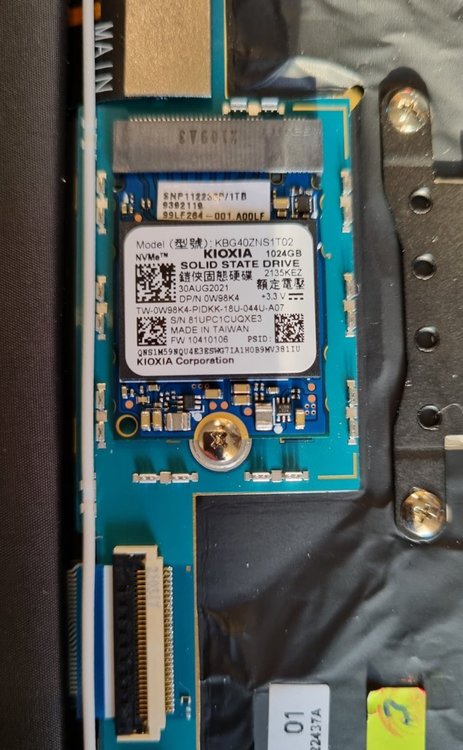-
Posts
218 -
Joined
-
Last visited
Content Type
Profiles
Forums
Events
Everything posted by John Ratsey
-
More and more components soldered onto the mainboard helps with reducing thickness and weight for those who want less of both - the challenge is to select something appropriate from among the limited hardware options on offer. I suspect that soldered components also improve reliability compared with socketed components although, if anything does go wrong, it's more difficult to fix. Regarding the ports, it's up to the potential purchaser to study what is on offer and select something appropriate to their needs. I recently bought one of these which has a good selection of ports given the size. My only complaint is that I'd like a full-sized SD card slot. However, on a more positive note I sense that's there are signs of a move away from the 16:9 displays (which should never have become mainstream) to panels which provide more vertical real estate. There was once a time when 4:3 was almost standard although the 80 columns x 8 lines of the Epson PX8's display could be considered to be the ultimate in widescreen.
-

Everyone, its time to decide our brand!
John Ratsey replied to Reciever's topic in Internal Announcement Discussion
It's slightly off topic for this thread but when @Aaron44126 has finished weaving his magic we'll be able to see all the old NBR threads. This example is for the Samsung forum but it's a matter of joining up the list here to the contents here. Your knowledge of the LG notebooks and forum will be useful in helping to build a sticky thread in the sub-forum listing the most important threads in the LG section of the archive. I've now got an interest in LG having recently purchased a Gram 17. -

What should I buy? Dell Precision 7740 vs Asus Strix G512L
John Ratsey replied to luisxd's topic in General Discussion
I'm late to this party but one advantage of the Dell brand is the publication of the service documentation. The Precision 7740 info is here . Some notebooks are easier to open up than others and Dell tends to fall into the easier category plus having the manufacturer's guidance to hand is useful. -

Everyone, its time to decide our brand!
John Ratsey replied to Reciever's topic in Internal Announcement Discussion
Well said and this echoes my own thinking. I also think that new users are more likely to come if the name found by their favourite search engine looks relevant and once we get the NBR archive linked in to the different notebook sections then this site will climb up the search rankings. There's also nothing stopping this forum having a desktop corner where members can discuss their desktops (many notebook owners have both) and sometimes it's useful to make comparisons between desktops and notebooks. -
Thank you for this very informative article. I hadn't done my homework before trying Windows 11 and one I found the taskbar problem (I like it up the left side of the screen so I can maximise the vertical real estate) I went back to Windows 10 without further exploration and didn't get as far as having Edge and Bing forced down my throat. Perhaps it would be better if Microsoft keep the Win 11 hardware requirements high because, as 2025 approaches, the outcry over the environmental consequences of lots of perfectly usable Win 10 machines being prematurely consigned to landfill may oblige Microsoft to continue to support Win 10 (bug fixes and blocking security holes) for several more years.
-

Notebook Review forum archive – NBRCHIVE
John Ratsey replied to Aaron44126's topic in General Discussion
Thanks for the confirmation and figuring out that I'd had a copy - past malfunction for the 2nd link.- 150 replies
-

Notebook Review forum archive – NBRCHIVE
John Ratsey replied to Aaron44126's topic in General Discussion
Am I right in thinking that once all the clever stuff is finished then all the threads here will be linked to the corresponding titles here? I can then make a sticky at the top of the new Samsung forum with links to some key threads in the archive.- 150 replies
-

What phone are you daily driving currently?
John Ratsey replied to Katja's topic in Mobile Devices & Gadgets
I'm currently using a Samsung S21 which i bought to replace an A8 (2018) primarily because of the better camera(s). I've two key requirements for a phone (i) small enough to fit in my pockets and (ii) the ability to take two SIM cards so I can add a local SIM when I travel. The S21 is a few millimetres bigger than the A8 and I see that the S22 is a few mm smaller so I might start looking around for one at a good price (ex-display or a return) once they have arrived. If the S22's camera zoom ability is better than the S21 then that's a further attraction. -
The challenge is to get this site well up the search rankings when people look for notebookreview.com. I see there's a mention at the end of https://forums.macrumors.com/threads/did-notebookreview-com-bite-the-dust.2331577/ . The more references we can scatter around the internet the better the prospects of people finding this forum.
-

What have you upgraded on your current laptop(s)?
John Ratsey replied to Sandy Bridge's topic in Components & Upgrades
Changing the SSD is the only upgrade I can do on this notebook. I suspect that most of the current crop of thin-and-light notebooks are similar. -
Here are some storage drives from my collection which illustrate most of the different sizes. Left to right: ADATA SU630 240GB 7mm thick 2.5" SATA SSD Samsung PM991a 256GB m.2 2230 nVME SSD (from a Samsung Galaxy Book Pro 13.3) Transcend TS512GMTS400 512GB m.2 2242 SATA SSD (an upgrade project which didn't work) Sandisk U100 128GB mSATA SSD (from an early Samsung Series 9 notebook - this SSD slowed to a crawl once it was nearly full) Kingston SA400M8 240GB m.2 2280 SATA SSD (from a Dell Optiplex desktop) Intel 660p 2TB m.2 2280 nVME (used in an XPS15 but taken out before the computer was rehomed) Toshiba MK2750FC 1.3GB 19mm (3/4 inch) thick HDD (approximately 1997 and probably came out of an AST Ascentia laptop). Laptop HDDs gradually got thinner. First to 12.7mm (1/2 inch) then 9.5mm (3/8 inch) with a few at 7mm (1/4 inch). Higher capacities needed more platters and thickness. The first portable (but needed mains power) hard drive I encountered (in 1984) was either 5 or 10MB capacity, was the size of a small shoe box and one had to remember to run a "park heads" command before shutting down the computer. Things have progressed since then.
-
I'll check tomorrow but I think I've got many of the different formats and will line some up for a photo.
-

Notebook Review forum archive – NBRCHIVE
John Ratsey replied to Aaron44126's topic in General Discussion
That's impressive. 🙂 Even complete with avatars!- 150 replies
-

Notebook Review forum archive – NBRCHIVE
John Ratsey replied to Aaron44126's topic in General Discussion
I only printed the list of threads - printing their contents would have taken an eternity. When you've sorted the CSS for your list then my PDF is effectively redundant although it may still be useful as a local reference.- 150 replies
-
What's the vision for the News & Reviews sub-forum? I presume that anyone can post relevant news there doesn't fit better in a specific sub-forum but what about reviews? Will that be a home for links to reviews elsewhere or can members make their own reviews and post them in this sub-forum?
- 152 replies
-
- suggestions
- requests
-
(and 1 more)
Tagged with:
-

Notebook Review forum archive – NBRCHIVE
John Ratsey replied to Aaron44126's topic in General Discussion
I took the precaution of printing a PDF of the most recent 10 years of threads in the NBR Samsung forum (in which I used to be very active) so I have a chronological list of the threads, including the sticky ones, plus the size of the threads. When I have a bit of idle time I'm planning to make a thread here linking to what I think are the most important ones going forward. Older Samsung notebooks had a few bugs and NBR members had figured out fixes for many of them and it's likely that anyone wanting to breathe new life into one of those oldbooks could well be looking for help. As I've recently bought an LG notebook I did something similar for the NBR LG forum but it's a much shorter list (were LG notebooks less buggy or just less common?). And if anyone needs a PDF of the NBR forum rules, I've got that as well.- 150 replies
-
- 2
-

-
I briefly tried Windows 11 but quickly reverted to Windows 10 when I discovered that I couldn't put the taskbar up the left side of the screen so I get maximum vertical real estate. It's set to small icons and is wide enough that I get time and date shown. I've never liked auto-hide so it's fixed. My most frequently-used programs are pinned to the taskbar.
-
As one who lives in GDPR territory and runs a small website with a mailing list and forum, my understanding of GDPR is that it was aimed at two things which are relevent here (i) No trading of peoples' details without their explicit consent (companies used to make money from these) and (ii) take reasonable measures to keep peoples' details secure. It would be prudent to note on the registration form that the details entered will only be used for this forum and not shared with others and the members' details should preferably be encrypted. However, I'm not too worried if the hackers get my email address as the scammers and spammers have had it for years due to a hack on a major software site.
-
I was invited to join the NBR mod squad at a time when someone, presumably with a grude to bear, periodically tried to hit the forums with porn spam so the more moderators, spread across different time zones, the better.
-
My recollection is that it was started by Andrew Baxter and Brian. I joined NBR in April 2005 when it was rapidly growing and Andrew would accept and publish a wide range of reviews by forum members (who got $50) to supplement those he did himself. The quantity and variety, was in my view, a valuable supplement to standardised reviews and must have brought more traffic to the site. NBR was one of several sites (Brighthand.com, DesktopReview.com, DigitalCameraReview.com, NotebookReview.com, PrinterComparison.com, TabletPCReview.com) under the technologyguide.com umbrella. By 2008 a reviewer / editor (Jerry Jackson) had been hired. Jerry's email address changed from @technologyguide.com to @techtarget.com in 2013 so I think that's when the sale to TT took place. The reviews became less abundant which would tend to reduce the traffic.
-
I let Windows 11 install itself a few days ago to see what it looked like, discovered that I couldn't dock the task bar on the left side of the screen (which I've been doing for years to maximise the veritcal space), tried registry hacks found by Google but they didn't work and then restored Windows 10. If Microsoft fix the task bar problem then I might try it again but this may mean waiting for Windows 12. History shows that Microsoft have a habit of making a mess of alternate versions of Windows.
-
I recently bought a 256GB Galaxy Book Pro 13.3 (model NP935XDB) with a 256GB SSD but wanted more capacity. The SSD is the 2230 size which isn't very easy to find with 1TB capacity. After much searching I found that Dell UK (as that's where I live) were selling a Dell branded 1TB 2230 at a relatively reasonable price (about double the cost of an equivalent 2280 SSD). The SSD I received is Kioxia (who bought the Toshiba SSD business) with a Dell part number on the label. After cloning using Macrium Reflect with the new SSD in an external caddy, I opened up the Samsung. The first step is to remove the screws under each of the four rubber feet and then peel the palm rest and base apart. This process is probably most easy started at one of the front corners after which it's a matter of working along the joint using a spudger or strong thumbnail to separate the plastic clips. Once the base (amazingly lightweight) is off then the SSD is hidden under the silver cover. The yellow label contains a reminder to disconnect the power adaptor and disconnect the battery (prise the connector upwards from the socket). Care is needed to remove the cover over the SSD. I used a very small flat-bladed jeweller's screwdriver poked into the small gaps at each corner of the cover in turn to carefully lift it while trying to not bend it out of shape. The SSD swap was then easy - remove one screw, slide out the old SSD, slide in the new one and replace the screw. Refitting the cover was much more time-consuming as the bottom of each side sits in some very narrow metal grooves and getting everying lined up and seated isn't quick. I wonder what the cover is for? Is it radiation shielding? Something thermal would normally be black although if it's in contact with the computer base then colour wouldn't matter (but why not use a thermal pad?). I then reconnected the battery and checked that the computer booted OK before shutting down and refitting the base. In addition to the extra capacity there's also a speed boost. CrystalDiskMark shows the speed of the 1TB for most tests to be about 20% higher than the original Samsung 256GB PM991a SSD but, for some reason, Seq Q32T1 writing is higher by about 60%. Samsung PM991a 256GB Sequential Read (Q= 32,T= 1) : 1980.763 MB/s Sequential Write (Q= 32,T= 1) : 1116.577 MB/s Random Read 4KiB (Q= 32,T= 1) : 501.342 MB/s [122397.9 IOPS] Random Write 4KiB (Q= 32,T= 1) : 495.957 MB/s [121083.3 IOPS] Sequential Read (T= 1) : 1269.407 MB/s Sequential Write (T= 1) : 1154.674 MB/s Random Read 4KiB (Q= 1,T= 1) : 43.412 MB/s [ 10598.6 IOPS] Random Write 4KiB (Q= 1,T= 1) : 164.910 MB/s [ 40261.2 IOPS] Kioxia BG4 1TB Sequential Read (Q= 32,T= 1) : 2377.243 MB/s Sequential Write (Q= 32,T= 1) : 1833.285 MB/s Random Read 4KiB (Q= 32,T= 1) : 616.300 MB/s [150463.9 IOPS] Random Write 4KiB (Q= 32,T= 1) : 503.722 MB/s [122979.0 IOPS] Sequential Read (T= 1) : 1438.888 MB/s Sequential Write (T= 1) : 1382.293 MB/s Random Read 4KiB (Q= 1,T= 1) : 59.772 MB/s [ 14592.8 IOPS] Random Write 4KiB (Q= 1,T= 1) : 193.423 MB/s [ 47222.4 IOPS] Nothing else is upgradable on this notebook. I would have liked 16GB RAM but , in addition to being somewhat more expensive, they are in the mystic silver colour scheme and I know from past experience that those keyboards are less easy to read as it's white backlit lettering on a silvery background. Samsung should be more innovative here. How about mystic maroon?
-

Notebook Review forum archive – NBRCHIVE
John Ratsey replied to Aaron44126's topic in General Discussion
This is an impressive accomplishment. I wouldn't know where to start. John- 150 replies
-
- 1
-





